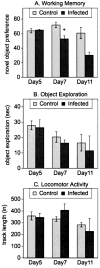Cognitive dysfunction in mice infected with Plasmodium berghei strain ANKA
- PMID: 18419550
- PMCID: PMC2692506
- DOI: 10.1086/587908
Cognitive dysfunction in mice infected with Plasmodium berghei strain ANKA
Abstract
Cerebral malaria complicated by cognitive sequelae is a major cause of morbidity in humans infected with Plasmodium falciparum. To model cognitive function after malaria, we created a rodent model of cerebral malaria by infecting C57BL/6 mice with Plasmodium berghei strain ANKA. After 7 days, an object-recognition test of working memory revealed a significant impairment in the visual memory of infected mice. This impairment was observed in the absence of confounding effects of infection. The cognitive dysfunction correlated with hemorrhage and inflammation. Furthermore, microglial activity and morphological changes detected throughout the brains of infected mice were absent from the brains of control mice, and this correlated with the measured cognitive defects. Similar testing methods in human studies could help identify subjects at risk for an adverse cognitive outcome. This murine model should facilitate the study of adjunctive methods to ameliorate adverse neurological outcomes in cerebral malaria.
Conflict of interest statement
Potential conflicts of interest: none reported.
Figures




References
-
- Newton CRJC, Krishna S. Severe falciparum malaria in children: current understanding of pathophysiology and supportive treatment. Pharmacol Ther. 1998;79:1–53. - PubMed
-
- Idro R, Jenkins NE, Newton CRJC. Pathogenesis, clinical features, and neurological outcomes of cerebral malaria. Lancet Neurol. 2005;4:827–40. - PubMed
-
- Taylor TE, Molyneux ME. Clinical features of malaria in children. In: Warrell DA, Gilles HM, editors. Essential malariology. 4. Oxford, United Kingdom: A Hodder Arnold Publication; 2002. pp. 206–18.
-
- Boivin MJ. Effects of early cerebral malaria on cognitive ability in Senegalese children. J Dev Behav Pediatr. 2002;23:353–64. - PubMed

